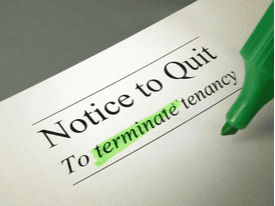How to Evict a Tenant in 9 Steps
As a conscientious landlord, you have completely vetted your tenants before renting to them. You’ve done a thorough tenant background check, searched for any criminal, eviction or fraud judgments against them and confirmed they were not terrorists or sex offenders. But as they say, life happens and sometimes even the most desirable applicant can fall on hard times, making them unable to pay their rent and therefore, a candidate for eviction.
While the general procedures for evicting a tenant are very specific, the steps toward a final resolution can be long and expensive. In addition, states and counties are at various points in the COVID-19 eviction moratorium process, which may require you to take certain steps not mandated by other municipalities. The information contained in this article is not meant to be legal advice. Contact your local housing authority or a real estate attorney to learn current laws affecting your property, its tenants, and how to evict someone.
Step #1: Do I have legal grounds to evict?

- Breaking the terms of your lease. This could include violating restrictions against excessive noise, pets, illegal conduct, such as selling drugs, conducting a business from your property or having unauthorized roommates who are not listed on the lease.
- Stays in the unit after the lease has ended. If the tenant refuses to move out after the lease has expired even though you have given them proper notice to do so, you may have grounds to evict them. This is one of the situations where you will need to find out if the property is in an eviction-controlled area and how to evict someone if it is.
- Damages the property. When a tenant damages your property in a way that decreases its value and they do not or will not remedy the problem, you may begin eviction proceedings. It could be possible for you to use the security deposit to pay for the damage, but chances are that the amount of damage will exceed the amount you are holding. Along with covering unpaid rent, Lease Guarantee can also reimburse you for property damage losses.
- Causes a significant nuisance to other neighbors and tenants. In addition to annoying neighbors with loud music or parties, your tenant might create a serious physical threat by allowing their dog to run around the property without a leash or by piling up trash in a common area.
You may not evict a tenant based on race, sex, religion, national origin, marital status, sexual orientation, number of children, job, physical or mental disability or because the tenant is receiving public assistance. You cannot lock your tenants out of their home, turn off their gas, water or heat to force them to move out. And you should never threaten immigrant tenants with unlawful methods to evict or threaten deportation.
The Landlord and Tenant Act explains the legal process on how to evict a tenant. The steps it outlines must be followed exactly or the judge may rule against you, which will allow the tenant to sue you in civil court. You may access this Act at a local court office, through a lawyer or from your state attorney general’s website.
Step #2: How do I give the tenant notice to quit?
 After serving the tenant with a 3-day Notice of Rent Due and then unsuccessfully negotiating with them in an effort to resolve the situation, you have made the difficult decision to legally evict the resident. In order to begin the eviction process, the tenant must be served in person with a legal notice to pay rent or quit by yourself or someone 18 or older.
After serving the tenant with a 3-day Notice of Rent Due and then unsuccessfully negotiating with them in an effort to resolve the situation, you have made the difficult decision to legally evict the resident. In order to begin the eviction process, the tenant must be served in person with a legal notice to pay rent or quit by yourself or someone 18 or older.
If you are unable to deliver the Notice directly to the lessee, it can be given to another adult in the renter’s home or at the tenant’s place of work. Alternatively, you may post a copy of the Notice on the home where your tenant lives. At the same time, mail a copy of the Notice to the tenant, preferably with a return receipt request. The tenant’s deadline to do what the Notice says doesn’t start until the day after it is mailed.
The person delivering the Notice must write a statement listing the date it was handed to the tenant or the adult who accepted the Notice on their behalf and also the date the Notice was mailed. The signed and dated statement must have these exact words: “I declare under penalty of perjury under the laws of the State of ________ that the foregoing is true and correct.” When you file the eviction forms with the court, you will need to attach a copy of this statement.
Once they have received the Notice, your tenant must act by the stated deadline. When determining the deadline, keep in mind that day 1 of the Notice is the day after it was delivered to the tenant in person or the day after it was mailed to them. If your Notice says your tenant can do something to fix the problem, like a 3- or 15-day Notice to Pay Rent or Quit or a 3-day Notice to Perform or Quit, then do not count Saturdays, Sundays or court holidays. If your Notice does not say your tenant can fix the problem by paying their past-due rent, such as a 3-day Notice to Quit or a 30- or 60-day Notice to Quit, then you count every day.
There is the possibility that the tenant will want to talk about the problem with you and/or a mediator and come to an agreement with you. If they do what the Notice demands by the deadline, you cannot start an eviction court case. But if they do not carry out the terms of the agreement by the cutoff date, you can then initiate eviction proceedings in court.
Step #3: How do I prepare to evict the tenant?
Once you have confirmed that the tenant has not met the deadline you established, you can legally proceed with the eviction the morning after the waiting period expires. There are certain papers you are required to include with the court forms:
- A copy of the signed lease or rental agreement and any written changes the tenant agreed to;
- Records of all communications between you and the tenant
- Bank statements showing missing rent payments or returned checks;
- A copy of the Notice you gave your tenant(s);
- A copy of the written proof that your tenant was given the Notice.
Step #4: How do I file my case with the court?
There are typically four forms that are required to proceed with an Unlawful Detainer Complaint. You will need the actual Complaint as well as the Plaintiff’s Civil Case Cover Sheet to be filed at the superior courthouse in the county where the rental property is located.
Also, complete the Summons-Unlawful Detainer-Eviction form. The clerk at the courthouse will give you the summons and a stamped copy of the Unlawful Detainer Complaint.
The fourth form you will need to submit is the Prejudgment Right of Possession. This form is used when someone not listed on the rental agreement is living in the unit. You cannot legally evict a person living in a rental who is not named in the complaint, so you’ll need to serve those unnamed occupants with a Prejudgment Right of Possession form and a copy of the complaint and summons. This action will automatically make them defendants in the lawsuit.
 Some courts have additional local forms they require you to use. Contact your county clerk’s office or check their website for more information on how to evict someone.
Some courts have additional local forms they require you to use. Contact your county clerk’s office or check their website for more information on how to evict someone.
Be sure to make copies of everything you are submitting as the court will retain the original documents. Also, make a copy for your records and one for each of the tenants and anyone else who lives in the home.
You are now ready to file the complaint at your local courthouse where you’ll have to pay a fee to start the process. The fee may vary depending on the amount of back rent you are owed. Should you not be able to afford the fee, you may be able to request a fee waiver if you receive public benefits, your income is below a certain amount or you can’t afford the fee while still meeting your basic needs.
After completing the paperwork, the clerk will give you a hearing date. Next, you’ll have the Summons and Complaint delivered to each tenant through a process called service or serving papers. This lets the tenant(s) know that you’re starting an eviction case.
If it is not possible for you to physically deliver your complaint to the courthouse in person, it may be possible for you to mail it or file online. Check with your local superior court to see if they offer these options.
The process of getting the tenant evicted typically takes about two months after you file the Unlawful Detainer Complaint form.
Step #5: How do I serve the summons and complaint forms?
If you are trying to evict more than one tenant, all of them must be served by someone over 18 who is not part of your case. It may be someone you know or a professional process server you hire. You may not serve them yourself. The service can be done anywhere, not only at their home.
The server must hand the tenant a copy of the filed papers by hand. If the tenant will not accept the papers, the server is allowed to leave them close to the tenant and say, “These are important legal papers for you.” The server will then fill out a Proof of Service of Summons form with the address where they served the papers along with the date and time of service and then give you the form to be filed with the court. Make one copy of the proof of service and file both the original and the copy at the court. The clerk’s office will stamp and return the copy to you for your records.
If your server is unable to locate the tenant, you may be able to try two other ways of serving them. The first option is called substituted service where the server hands the forms to another adult in the tenant’s home or someone at their place of work followed by mailing a copy of the same forms to the tenant at the address where they handed someone the forms. Service is not officially completed until 10 days later. The second option, service by posting, is when the server posts the forms on the tenant’s home and then mails a copy to them (sometimes called “nail and mail”). The court will have to be asked for permission to use the service by posting method after the other methods have been attempted. The server must write a statement for the judge explaining when they tried to serve and why they weren’t successful.
If the judge lets you serve by posting and mailing, your server has to place a copy of the Summons and Complaint on the property where the tenant will see it and then send another copy by certified mail to the renter at the tenant’s home address. Service is considered complete on the 10th day after the papers are mailed to the tenant.
Step #6: They’ve been served, but they didn’t answer. Now what?

If the tenant doesn’t respond within that time period, you can request that the court make a decision without a trial by issuing a default judgment and ordering the tenant to move out. In order to accomplish this, you need to mail a copy of a Request for Entry of Default to each tenant. As soon as you file this form, your tenant is no longer allowed to file an Answer.
The next action is to use a Judgment-Unlawful Detainer form. Be sure to check off “By Clerk,” “By default” and “Possession only.” The clerk will file it and request that the judge issue an order that you now have the right to regain your property. Once you have a default, you can ask for a Clerk’s Judgment of Possession of Real Property. This is the form you will give to the sheriff to evict your tenant so you can get your property back.
Be aware that if your tenants were served on different days, they will have different deadlines to respond. If one tenant missed the deadline to respond and the other still has time to answer, you can ask for a default for the one who missed the deadline and then request another default for the other person when their time to reply ends. You could also wait for all the deadlines to pass and then ask at once for a default for all the tenants that do not respond.
Be aware that you won’t be able to include back rent in this Clerk’s Judgment for Possession. You can ask for the money you’re owed in a separate default money judgment.
The court takes longer to process judgments asking for back rent. If you want your tenant to move out as quickly as possible, file the Clerk’s Judgment for Possession first, then the judgment forms asking for back rent.
Step #7: My tenant filed an Answer. What’s next?
If your tenant files an Answer form, it means that they want to fight the eviction by telling their side of the story in court. If they do not send you a copy of the Answer, you can look up the case at the courthouse.
File a form called Request to Set Case for Trial-Unlawful Detainer at the clerk’s office to continue the case. Once again, you will have to serve the tenant with the complaint and summons and file a proof of service with the court. The court clerk will then mail you a letter with your trial date.
You or the tenant may ask for a trial date, which is usually set within 10 to 20 days after the request. The time frame may vary depending on your area. You cannot collect rent from the tenant while awaiting a trial, but the tenant will still be responsible for rent payment.
The tenant has five business days to file a response to the court to challenge the lawsuit. If the tenant fails to respond after the five business days, you can ask for a default judgment by filing another form with the court. The clerk of the court will set a court date and you will have to give the judge enough evidence to show that you properly went through the eviction process and the tenant defaulted.
Step #8: What will happen in court?

You may be asked by the judge to step out of the courtroom with your tenant to try one more time to reach an agreement without a trial. If you do finally agree, tell the judge what you both agreed to. If you need more time for your tenant to perform according to the agreement, ask the judge to move the trial to another day. At that time, you can dismiss the case if the tenant has satisfied his commitment. Be sure to get a copy of the Judgment.
If you and the tenant cannot agree, the trial will begin, you will present your case and the judge will decide to either continue the eviction or allow the tenant to stay at the property. If you win the case, the judge will give you instructions on how to evict the tenant.
If your tenant did not appear at the trial, you must serve them with the filed copy of the Judgment so they know what the judge ordered them to do.
Step #9: How to evict a tenant after the trial
If you have succeeded in winning your trial, you will receive a Writ of Possession to start the eviction process within five days and collect any money the tenant owes you.
Depending on the circumstances and provisions in the rental agreement, the court may also order the tenant to pay any unpaid rent, attorney’s fees and/or a penalty. A landlord cannot legally try to evict a tenant without the Writ of Possession from the court and without having a sheriff present during the eviction.
The sheriff typically has three to 15 days to post the notice on the dwelling; then, the tenant has five days from the date of the notice posting to vacate the property. If the tenant does not leave, the sheriff will return within six to 15 days to physically remove the tenant from the property and place any personal possessions on the curb. Since you can sue the tenant for major damage in civil court, bring a camera with you and inspect the property carefully.
If you purchased a LeaseGuarantee contract at the beginning of the tenant’s lease, log in to your AAOA account and click on Tenant Screening to request reimbursement. You will need a signed lease agreement, signed rental application and a copy of the court judgment.
If you do not prove your case in court, your tenant must be allowed stay in the home and you might be required to pay some of their court costs. The tenant will still be required to adhere to the terms of the rental agreement.
Evicting a tenant is a lengthy, stressful and complicated process that may be avoided by carefully scrutinizing your applicants’ credit report, past rental history and criminal background. Beware of real estate scams, such as counterfeit pay stubs and fake Social Security cards. Check landlord and employment references and look for discrepancies in the application. By following this process, you can avoid losing rental income and prevent getting involved in a lengthy legal matter, which could take months and a great deal of money to resolve.
The information provided herein is for advisory purposes only and AAOA takes no responsibility for its accuracy. AAOA recommends you consult with an attorney familiar with current federal, state and local laws.
AAOA Can Help
Looking for additional resources designed for landlords? AAOA offers industry-leading services and materials to help you make the most informed decisions possible regarding your rental properties.















 Accessibility
Accessibility